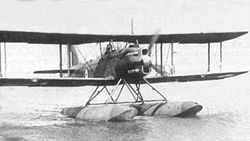Fairey Seafox
| Fairey Seafox | |
|---|---|

|
|
| Type: | Reconnaissance aircraft as a float plane |
| Design country: | |
| Manufacturer: | |
| First flight: |
May 27, 1936 |
| Production time: |
1936-1937 |
| Number of pieces: |
64 |
The Fairey Seafox was a catapult capable seaplane made by the British manufacturer Fairey Aviation Company , which was used by the Royal Navy during World War II .
In use since April 1937, the biplane with two floats served as a reconnaissance and observation aircraft on various Navy cruisers. The Seafox had its most remarkable mission in December 1939, when a machine stationed on the cruiser Ajax was able to observe the actions of Admiral Graf Spee for a long time during the battle in front of the Río de la Plata .
In total, only 64 aircraft were built.
Technical specifications
| Parameter | Data |
|---|---|
| crew | 2 |
| length | 10.20 m |
| span | 12.19 m |
| height | 3.68 m |
| Wing area | 40.32 m² |
| Empty mass | 1726 kg |
| Max. Takeoff mass | 2559 kg |
| drive | a sixteen-cylinder Napier Rapier VI H (395 hp) |
| Top speed | 198 km / h at an altitude of 1780 m |
| Marching speed | 171 km / h |
| Service ceiling | 2957 m |
| Range | 708 km |
| Armament | a 7.7mm machine gun |
See also
literature
- HA Taylor: Fairey Aircraft since 1915 , Naval Institute Press, 1974, ISBN 0-87021-208-7 , pp. 283-288